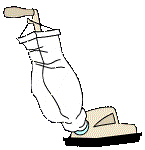|
|
The World Book Encyclopedia definition for geckos is:
1. any one of a group of small, insect-eating lizards, often having adhesive pads on the feet for climbing. Geckos are found in the temperate zone and are harmless to man. They are active chiefly at night.
![]() Back to top
Back to top
 Comments
CommentsFirst of all, a little “story telling” here, because the way geckos came into my classroom was a surprise - to me at least! The first time my husband and I saw an adult gecko in a pet store, we were immediately attracted by its lovely black and yellow colour. The second positive feature was that it was easy to handle- it climbed quite casually up our arms and then settled in for a “nice little rest”. Hmmm, I said. This will definitely be my choice when I next have a free cage in the classroom. There was a big drawback, however... the price! Ninety dollars, before you even buy the tank and heater, is a hefty price for a classroom pet. As luck would have it, Christmas was not too far away. Guess who got a gecko, complete with tank, heater etc. from Santa! Next stop... Mother’s Day! Guess who got the “opposite sex” of gecko! I always laugh that most ladies receive flowers on Mother’s Day! I’m lucky... I got both! So now I have both a male and a female gecko. The story isn’t quite finished though! Sexing is not always a sure thing in the youngsters. The male gecko from Christmas turned out to be a female. Here’s where luck really was on my side... the female gecko from Mother’s Day turned out to be a male!
I quite enjoy having a Leopard gecko as a classroom pet. It is definitely attractive and it is compliant to gentle handling as well. It almost never bites, and the bite is not painful. (Actually, the only time I have ever been bitten is when I was handfeeding a too-small mealworm!) One warning here... be careful with the tail because they can drop it off if they feel threatened. Leopard geckos grow to about 20 cm. (8 inches) and have stocky bodies... which makes for a really nice-to-handle size! Feeding and tank maintenance are both quite easy. Every once in a while there is a spectacular skin shedding to get everyone checking the tank hourly! We were very lucky one time to get an almost full skin before the gecko ate it. All the little toes were there and even the spots showed! I bring my geckos to school one at a time, as they have not been paired for mating yet. While the basic appearance is the same, they definitely have different personalities. Spotty (female) is a snoozy food hog while Speedy (male) just loves to dig up piles of sand and even climb the rubber cactus.
A big drawback to these pets is the price. The gecko itself is expensive and the tank setup, if done properly, is also pricey. After doing some investigations on the Internet, I found that the cheaper rock heaters are not advised. I now have the more expensive under-the-tank heaters. The tank setup is quite heavy, so I bought a separate tank setup to remain at school. Theis way the gecko can easily travel to school with me on Mondays and home again on Fridays in a little plastic container. Another consideration concerns feeding. Leopard geckos quite readily eat mealworms and crickets, however, once in a while an adult gecko should get the extra nutrition of a pinkie (baby mouse). I do NOT feel this is appropriate for elementary school, and so this task is done strictly on weekends!
![]() Back to top
Back to top
Leopard geckos are not all that active, so a ten gallon glass tank will be just fine if you have only a single pet. A fifteen gallon tank could house one male and one female, (or two females) providing there are two separate hiding places. Plastic box cages can also be used, but you will have to be careful about what you choose as your heat source. Although Leopard geckos cannot climb glass, a sturdy mesh lid is still needed to keep out foreign objects and keep in the insect prey. A heat source must also be provided. Rock heaters are generally not advised, so purchase the more expensive under-tank heater. Keep it at one end of the tank so that there is a temperature gradient allowing your gecko some choice. Leopard geckos absorb most of their body heat from the substrate, but cannot tolerate prolonged cool air temperatures. This is an important consideration if the room you are keeping them in is cool. You may wish to line part of the outside with cork. An artificial light source provides some extra heat and also lets you view your pet easily. However, Leopard geckos are primarily nocturnal animals and so do not like really bright lights. Be sure that the temperature does not drop too low when you turn off the lights at night. You could also use "reptile night lights", but safety is another factory you would have to consider. When choosing a location, do not place your tank in a sunny area. Temperatures will become far too high in the tank. A desirable temperature on the sand surface is about 84-88 degrees F. Commonly used substrates are fine sand, artificial turf, ground corn cob, and newspaper (pine shavings are not recommended). A shelter as well as a water dish is needed. Keep the water at the far end from the heat source. Keep a sponge or cotton batton ball in the dish so that the silly crickets can climb out. Keep the shelter partly on and partly off the heat source. Artificial or real plants add to the attractiveness. Some way of supplying humidity is important for proper skin shedding, but it is very important that the tank does not become damp. One suggestion is to spray the area under the hiding place. Another is to use a wet box.
My tank setup is as follows: a ten gallon glass tank, a wire mesh lid, an under-the-tank heater placed at one end of the tank, a single fish tank light canopy on top, a reptile thermometer, sand substrate, ceramic hiding place, water dish, and a plastic cactus. The light is turned off at night. To comply with humidity needs, I supply a wet box at night.
![]() Back to top
Back to top
Mealworms and crickets purchased from the Pet Store are the main food staple. A vitamin supplement is necessary. It is quite easy to “dust” the food before “serving”. Put a little vitamin powder in a small yogurt or margarine container and “shake” the mealworms or crickets in it before serving. Waxworms, not as commonly available, are permissible as an occasional treat. (They are very high in fat content). While geckos will also eat a great range of wild caught insects, you must be careful that they are free of pesticides and so on. Water is provided in a sturdy shallow dish. It is changed daily.In my tanks at home (remember, my geckos rotate "turns" at school) I also keep a small dish of scraped cuttlebone.
Adult geckos benefit from the occasional “pinkie” (baby mouse) available from the Pet Store. Females are more inclined to eat them than males. Personally I find this an unpleasant task and I strongly feel it is NOT suitable for the classroom. Take care of this yourself.
 Maintenance
MaintenanceThe day-to-day maintenance of Leopard gecko tanks is very simple. They defecate in one area of the tank, and the stools are quite dry and easy to remove. It is also advisable to remove the general sand area underneath at the same time.
Most problems are associated with excess moisture. This consideration is largely circumvented by using a wet box. Every night I place a small plastic sandwich container (hole cut in side, lid left on) with a couple of wet paper towels in it in the tank. I remove it each morning and replace the paper towels. This gives the gecko a daily “moisture booster” to aid in the shedding of skin, without promoting damp conditions in the tank itself. Additionally, the gecko can “choose” whether or not to go in the wet box!
All gecko supplies should be removed and cleaned weekly. Hot soapy water, a bleach solution soaking (15 to 30 min.), and a good rinsing are necessary. I keep a kettle in my classroom as it is easier than hauling buckets down the hall (we only have cold water). The bucket is "reptile use only" ! When removing feces, I scoop out the sand underneath too. At the beginning of the school year, it is easiest to go buy a new bag of sand for the initial set-up.
![]() Back to top
Back to top
Family: Gekkonidae Subfamily: Eublepharinae
The scientific name of the leopard gecko is Eublepharis macularius. This means Eu=good, true; blephar= eyelid; macularius=spotted. There are basically two types of geckos - those with movable eyelids and those without. Leopard geckos do have eyelids and they have clawed feet which help them climb rocks. They do not have the fine, adhesive lines on their feet which allow other gecko species to climb glass. They lay parchment shelled eggs.
They come from the dry, rocky areas of eastern Iran, Afghanistan, Pakistan, and north western India. Most of today’s captive Leopard Geckos originated from Pakistan.
 Characteristics
Characteristics• Leopard geckos grow to about 20 cm. (8 in.) and have stocky bodies and thick tails. They can drop their tails (autotomy) if they feel threatened. The tail will grow back but it has a different skin texture (smoother) and is somewhat fatter.
• They have well-defined eyelids. They clean their eyes with their thick tongues.
• They have clawed feet which do not permit the climbing of glass.
• The ear holes (drums) are situated on the head so that the light shines through!
• Babies have broad black stripes on a yellowish beige background. These stripes later break up into the adult pattern of spots.
• The skin is dry and bumpy in texture. They regularly shed their skin and then eat it.
• They are nocturnal. They like to hide in burrows or piles of rocks.
• They hunt their food by sneaking up on it and darting quickly. They sometimes wag their tails just before pouncing.
![]() Back to top
Back to top
• Study the basic anatomy of the Leopard gecko. Pay particular attention to the eyelids, the ear holes, the five clawed toes, and the base of the tail where it is pinched in just a bit.
• Describe the pattern of spots on its body. How does the background colour vary?
• Observe how it walks. Watch the sinuous body movement and the pattern of the legs.
• Observe how it eats. Pay attention to the darting motion and the tail wagging.
• Can you find out what kind of movements attract its attention?
Black, Jesse, Keeping and Breeding Leopard Geckos, in Reptiles magazine Volume 5 Number 3, March 1997, pages 10-18
Coote, Jon, Leopard Geckos: Their Captive Husbandry & Reproduction, Nottingham,U.K.: Practical Python Publications, 1993
de Vosjoli, Philippe, The General Care and Maintenance of Leopard Geckos, California: Advanced Vivarium Systems, 1990
Hunziker, Ray, Leopard Geckos: Identification, Care & Breeding, U.S.A.: T.F.H. Publications, Inc., 1994.
![]() Back to top
Back to top
Heather’s Gecko Page
This enthusiastic web site has good care sheets and references..
http://www.geckoworld.com/~gecko/
Leopard Gecko Care by Chris Norman. Good basic care info.
in Melissa Kaplan’s Herp Care web site
http://www.sonic.net/~melissk/lep_gek.html
and Chris Norman's own web site on Leopard Gecko Care
http://www.geckoworld.com/~gecko/docs/leopard.html
Special Needs of Classroom Reptiles - in Melissa Kaplan’s Herp Care web site
Melissa gives many sound reasons why NOT to keep a reptile in your classroom!
Read this article before deciding for yourself. Melissa has the animal’s well-being at heart and she is right on about the many pitfalls that you should consider!
http://www.sonic.net/~melissk/classpet.html
Leopard Gecko Care Sheet: The Perfect Reptile Pet by Alan & Billie Zulich (Harford Reptile Breeding Center)
Good care sheet by enthusiastic breeders
http://orsp1.adm.binghamton.edu/~steve/GECKO/
Leopard Gecko Care Sheet by Steve Hallas
a care sheet
http://www.cyberspc.mb.ca/~stevenha/geckocr.txt
| Getting around in this Web site |